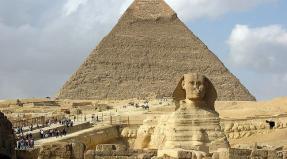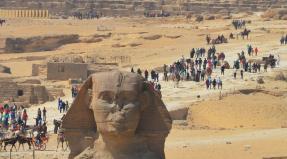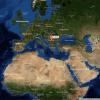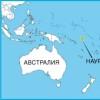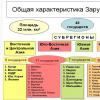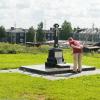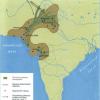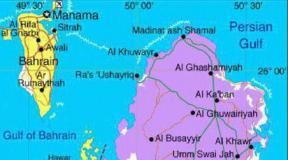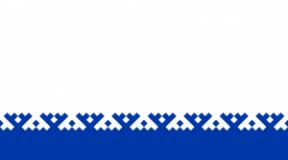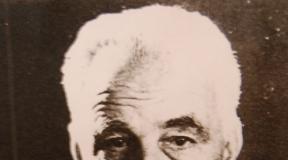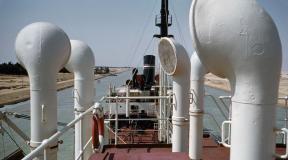Magadan roads. Kolyma track. When there are more bears than people
"The next morning, loading began. The trucks were loaded with a crane. Then we got onto the barge. There was another car - a heavy-duty one. The driver was driving it somewhere. We pitched a tent on the barge and prepared for a long journey along the Aldan River, then along the Lena river and further to the Skovorodino station. We should have had enough food to the final point of the river journey. Finally the tug gave a signal and our barge started and went along the river.
The mood is good, everything is going according to plan. Endless taiga along the shores.
A few days later, waking up in the morning, we did not hear the usual noise of the tug. The barge was anchored at the mouth of the Aldan River. It turned out that our tugboat had been recalled to remove the motor ship that had run aground. This did not upset us, we hoped that he would quickly return to us. A few tens of meters from our barge there was another one, and the tugboat left there.
We, as I have already said, are great optimists, but I gathered a family council and proposed to start saving food. I did not find support, but I was also criticized for sowing panic. We, as always, cooked lunches for everyone, well, breakfasts and dinners with our family. After a few days, food began to run out. The men were also worried. We listened all the time to the river, if we could hear the noise of a ship going by. The "Skippersha" told us a story that a year ago she had already wintered with her barge and now always carries several sacks of flour with her. It scared us very much. We ran out of sugar, canned food and all other supplies. "Skipper" once a day fed the children with pies. The men were fishing, however, there were only two rods, but still reinforcements sometimes came.
The barge was not far from the shore, and our men went to the taiga in the hope of shooting something. They were afraid to go far, if a tug came, they would not wait long. Each time I tried to persuade them not to walk for a long time. They found wild garlic in the forest. It was impossible to eat these green vitamins without bread, I added it to fish soup.
One night, I woke up to hear a splash. The boat was lowered into the water, and the whistle of a steamer was heard on the river. Our starving men swam closer and explained the situation that we were abandoned by a tug, and children on the barge. They asked the captain if they had any extra food. They were very upset that they could not help us, but they gave us several loaves of dried black bread. They promised to report our plight. We soaked this black bread and ate it with wild garlic and fish soup, which caused everyone to have heartburn. My youngest son, Valery, asked me: "Well, at least a small piece of white bread can be lost somewhere?" I persuaded the children and encouraged the men as best I could. Two or three days later, the whistle of a passing steamer was heard again at night. He "slowed down" his move, waited for the boat from the barge to reach them. This time we were given food: condensed milk, all kinds of bread, canned food, etc. My husband woke us up in the middle of the night, put the kettle on to heat. And the boys drank tea with condensed milk and white bread. We were also warned not to leave the barge, because promised to send a tug. They continued to fish, but they did not go ashore.
Finally, after two weeks of inactivity, a tug arrived. I picked up the barge and with merry honking we set off towards Yakutsk. Everyone perked up. "
Due to production needs, we needed to visit the Far East. It is not interesting to fly there by plane, it is much more interesting to come by land, to see people, to show oneself, fortunately, the Russian "ROUTE-66" "Moscow-Magadan" is gaining popularity lately, which, after the introduction of bridges across Bolshoi Selerik and Elga, began to pass without fanaticism, for the travelers who had overcome it earlier on the old Kolyma highway through Oymyakon, experienced considerable difficulties and wetness. The old Kolyma highway was named "The Road of a Thousand Puddles", but thanks to the Party and the Government, in 2008 a test passage to Magadan was finally opened along a new highway through Ust-Nera. And we decided on the route Moscow - Yakutsk - Magadan - Moscow on the UAZ "Bukhanka", which in the course of its passage turned into a route Moscow - Yakutsk - Magadan - Vladivostok.
"Do you know, brother, what kind of Kolyma is she? I feel sorry for those who do not know the edge of this."
Alexander Rosenbaum
I flew quickly to Kazan, with an average speed of 90 km / h. At the checkpoint outside Kazan, some kind of raid was apparently carried out on drunks, everyone was slowed down and forced to blow into a tube. I blew too. Everything is clear, like on a conveyor belt, one traffic police officer brakes everyone and directs them to the post. The second works with a breathalyzer. There is a whole queue of people suspected of drunkenness, so the traffic guards do not make any unnecessary gestures. He blew, waited for the green whistle on the device, and drove on. But they apparently have enough clientele. A drunk Tatar was caught in front of me. He first spoke to them in Russian, and when he got caught, he switched to Tatar. As soon as he spoke in the local dialect, he was taken to a separate booth, probably to talk to his heart's content in his native language without prying ears. I spent the night outside Kazan at a cafe, having previously dined in it, and moved to Ufa. In front of Naberezhnye Chelny they again stopped, but not at the post, but in the field. Who followed me too. Imputed violation of the sign "Overtaking is prohibited", although it was intermittent. I was the first. I was immediately informed that they would immediately deprive me of my rights if I did not think well, for which I offered one hundred rubles simply out of respect for the servicemen. The servicemen were dumbfounded by such a meager amount, but then the second stopped carrier came to the rescue. He began to be loudly indignant that he would call KPO and CSS, that this was a clean water divorce and so on. In general, while I was sitting in the elder's car and paying off with a steward, he was released free of charge. It became a shame that he was in a hurry, he could also leave for free. The road to Ufa is good in places, bearable in places. I slipped through Ufa along the bypass, after 20 kilometers I got stuck in a traffic jam. Repair of the bridge over the river, the name of which could not be found out, tk. there was no sign. Run on one side in reverse. For three and a half hours I stood and listened to the foul language of truckers from the radio, and they said that there would be one more problematic place.


The market place near the road near Sim has grown even more compared to last year. Business is booming. I stood here for half an hour less, only 3 hours. I drove over and moved to Chelyabinsk. It was getting dark. And in the Ural Mountains, a downpour hit me. Most of the long-range fighters dropped to the side of the road where they could fit. I drove 30 kilometers under the downpour and reached a cafe. Horror. The road soars, darkness, nothing is visible, pouring like a bucket. Trucks that did not get up, shakes along the road. Horror. I slept, ate and went to Omsk. On the bypass Chelyabinsk I discovered an interesting settlement - Balandino. Immediately I remembered an advertisement for beer "What they drank in Malye Chekushki is understandable, but in Bolshoye Kruzhki they drank beer." I didn't try what they eat in Balandino, I photographed it and drove on.

With the collapse of the USSR, there was a joke with the M-51 main road, a part of it, a very small piece, got into the territory of sovereign Kazakhstan, and in order to get to Omsk directly, you need to go through four customs. Two at the entrance and exit. Therefore, of course, no one drives directly, everyone takes a detour through Ishim-Berdyuzhye. The road was made bearable, there are more good sections than bad ones. Traffic in the evening to Ishim is very small, there are almost no gas stations. The road was practically rebuilt. Those terrible ruts with trucks dusting on them, pictures of which I saw in the Internet, are gone. There is asphalt all the way to Omsk, but in some places there are quite decent holes. You have to be careful.

In the middle of the fourth day of the trip I am in Omsk. Tired of three nights of sleeping in a UAZ, I decided to fit into the hotel in order to wash and relax. The municipal hotel "Irtysh" was discovered, of course, on the banks of the Irtysh. The hotel, apparently, is kept for visiting officials from the Center, therefore it is very decent, although relatively cheap. Having fit in, I went for a walk around the city and find where to eat. Found an interesting ad.

They remember the Supreme Ruler of Russia in Omsk. True, the advertisement looks somewhat familiar. Could at least stick a solid sign to the surname, like "Kolchak". It would have turned out to be old-fashioned and solid, otherwise the name is simply lost in signs such as "Cafe Uncle Kolya" or "Bar at Mikhalych". Omsk pleased with the culture of drivers on the streets, organization of traffic and hospitality. I'm going to Novosibirsk. The road to Novosib is very pleasant, empty and almost perfect.

It seems that they began to build it anew instead of the old tract in 1999 and brought it to the end. I regretted that cruise control was not provided on the loaf, it would be very useful. You can roll all 650 kilometers with a breeze. A large car like "Volga" can fly 140, occasionally overtaking wagons. At the cafe at the fork with Chans I came across the Russian "SCHOOL-BUS". Local children, like Filippka, do not have to go to school 10 kilometers away in the cold.

The cafe in Chany surprised us by offering all kinds of cakes and quality tea on the menu. Ate Eclair and some Wasp Sting. You won't find such high-quality cakes on every corner in Moscow, but here on the highway, in a diner, where long-range soldiers are fed with traditional kebabs, goulash and pasta. I liked it very much, I recommend it. By the evening I was in Novosibirsk. I spent the night in Tolmachevo and went to Kemerovo. The road to Kemerovo is quite good. Again, I go 80-90 km / h stably.

I have met two auto transporters with license plates from St. Petersburg and Moscow Region. They are carrying Hyundai and some other quick-eyed foreign cars. He asked on the radio what they were doing here and they said that Japanese and Korean women come to St. Petersburg by ship by sea, and then they are transported by auto transporters across Russia up to Chita. The ways of logistics are inscrutable! It is easier for cars to sail around the mainland and drive half of the country in auto transporters in the opposite direction than to sail to Vladivostok and arrive to customers by rail. Kemerovo does not have a bypass road, but it is easy to pass through the city following the signs. The road first goes past "Azot", which is full of smoke with pipes, despite the crisis, then a couple of times winds along the main streets of the city and goes to M-53. The quality is also on a solid four. There is almost no traffic. There is silence in the radio, there are practically no long-range players. I'm going to Achinsk. Again, there are no problems with the road.

The route passes through Mariinsk with a very confusing route map, but if you follow the signs, then there will be no problems. On the right, at the entrance to Mariinsk from the Moscow side, the zone is on display in all its glory. It makes an impression. It seems that all the horror stories that things are bad with the M-51 and M-53 roads do not correspond to reality, there is no point in going around through Tyumen or in other ways. Several times I met road workers who were doing something on the routes that were almost ideal for Russia, it seems that the roads in the central part and Siberia began to be monitored properly. There are many times more bumps and holes from Moscow to the Urals than in Asia. In Achinsk, I checked into the Arkada hotel, which even had unlimited Internet, and the rooms had instructions on how to use it, which was clearly not written by a computer scientist, and it is difficult for a non-specialist to get free access following it.

For those who do not have a personal computer with them, the administrator issues a laptop for the duration of their stay, free of charge. This is a service! We are in the European part to such as to the moon. In the morning I wake up and go through Achinsk to Krasnoyarsk. The traffic is not intense, there are signs, I didn't have to fornicate. Nice town. By the way, Achinsk has a bypass, and you don't need to enter it unnecessarily.

Achinsk is undeservedly offended by its popularity, unlike Shushensky, who is known to every Soviet person, and in fact, Comrade Stalin served the rest of his exile in it, and from here on March 8, 1917, he left for St. The future great scientist, who knew a lot about linguistics, was transferred to Achinsk from the Turukhansk Territory, where in the village of Kureyka he was under the supervision of the tsarist secret police for almost 4 years, along with another famous revolutionary and future chairman of the All-Russian Central Executive Committee, Yakov Mikhailovich Sverdlov. Later, Kureyka became famous thanks to the hydroelectric power station located there, which supplies the Norilsk Industrial District with electricity. During my stay in Norilsk I tried to find out something about this interesting fact from the old residents, but no one knew anything. It's strange. In Moscow, on every house where at least someone from the top of the CPSU (b) appeared during or before the October events, there is a memorial plaque, and here is such a gap in the history of the Party. Today, the Krasnoyarsk Territory is also full of penitentiary institutions. Moreover, the Federal Penitentiary Service for the Krasnoyarsk Territory is one of the most advanced in Russia. In addition to the latest technical means for the protection of prisoners, they introduced such an innovation as video meetings. Z / k and relatives who have arrived on a date communicate via video communication.

The price is very affordable, 10 rubles per minute. But, nevertheless, it is worth admitting that for the same 10 rubles you can talk to Tel Aviv or the USA, and not for one minute, but for 5 minutes. What can you do, natural monopoly. Or the unknown secret laws of physics, according to which the bandwidth of a channel behind a barbed wire 300 meters long is equal to the bandwidth of a channel in a wild, thousands of kilometers long, although sometimes, indeed, in some environment "knocking propagates faster than sound."

The road to Krasnoyarsk again presents no surprises, as well as its recently built bypass. The usual speed is 80-90 km / h. When approaching Krasa, the 92nd gasoline rose in price by 3 rubles. From Moscow to Kras, it cost from 19 to 21 rubles per liter, and after Krasnoyarsk it began to cost from 22 to 24 rubles. Having lunch in a cafe in front of Kras, I ate a very high-quality salad of cucumbers and tomatoes. I decided that the vegetables should be local. This assumption was later confirmed. Passing the bypass, I noticed an abundance of greenhouses. It turned out that the Chinese were in a hurry, they created a Chinese state farm on Russian lands. They know how to turn around, but there are rumors that the vegetables they grow contain nitrates and other nasty things.

Crossing the Yenisei across the new bridge, I was surprised at its relatively small width. I'm used to seeing the Yenisei in Dudinka wide, so that the other bank is almost invisible. True, up to Dudinka, a bunch of large and small rivers flow into it and, apparently, the Yenisei in this place has not yet gained all its strength. The road to Kansk on a solid four. Only in front of Kansk do small pits begin to come across, requiring attention and speed reduction to 50-60 km / h. In the vicinity of Kansk, the 23rd Guards Missile Division of the Strategic Missile Forces was deployed, which at the time of the disbandment in 2007 of the Topol RS-12 family of ground complexes, remained in service, but the Navy's arsenal and a military airfield with the MIG-31 based there remained. Airfield PVO, therefore, has a very powerful fleet of radars that stand right along the road. Here is one of the P-30 upgrades revolving briskly:

In Kansk, Konstantin (SKDingo) invited me to visit. He fed, watered, put him to sleep and drove around Kansk, for which many thanks to him. At Konstantin's, I meet with Alexander (D-144m) from Khabarovsk, who arrived in Kansk a day later. Historical photograph "Batons from all over the country are found in Kansk - the center of Russia."

View of Kansk and the Kan River from the former military town of the Strategic Missile Forces (ZATO Solnechny), transferred to the municipal authorities and now inhabited by civilians:

I leave for Irkutsk. After the Lower Ingash, the fun begins. Lower Ingash is a well-known name. If Tula is associated with a samovar, and Orenburg with downy shawls, then Nizhny Ingash is strongly associated with the back of the body. It is worth mentioning this name when communicating with any truck driver, as the answer will sound: "Lower Ingash is an ass". I must say frankly, this ass is not the largest in Russia, but the most famous is undoubtedly.

Much has been written about the section of the federal road from Nizhny Ingash to Nizhneudinsk, its deplorable state is known to all long-distance motorists, but nothing has changed for decades. One gets the impression that this "attraction" is not specially renovated and is preserved in its original state, like some architectural monument of the past. After all, disappear, this "zest" and the Lower Ingash will be ingloriously lost in the Russian expanses like thousands of other roadside settlements. Although some work to eliminate this outrage is being carried out. An embankment is being poured, there are signs "Detour" and "Road repair" everywhere, there are finished pieces of asphalt several kilometers long. But all this is done somehow sluggishly, it seems that more for show. The road, or rather a grader, passes through Taishet, which turned out to be a large village. Taishet is a large railway junction on the Transsib.

Here BAM begins and a branch from Abakan comes here. By the way, the eastern roads are electrified with a change of 2x25 kV, in contrast to the railways of the European part, where the direct current is 3 kV. And the electric locomotives are much more powerful here. The Abakan branch is less known than the Baikal-Amur Mainline, but they are close relatives with it. They started both BAM and Abakan-Taishet back in Stalin's time, by the forces of prisoners of the Main Directorate of Railway Construction Camps (GULZhDS). Both of these projects were thwarted by the Great Patriotic War. These construction projects were continued already in the Khrushchev time by the forces of the Komsomol, not disdaining the work of the remaining special contingent. Yuri Vizbor sang about Abakan-Taishet and about BAM. But everyone knows BAM, and Abakan-Taishet got much less public attention. Although, in terms of difficulty and human lives, the branch to Abakan ranks second among the railway projects of the USSR after the Salekhard-Igarka road, abandoned after the death of the Leader and still unfinished. I passed Alzamai with the famous motel "At Petra", but did not stop. I wanted to get through the grader quickly. Asphalt started 40 kilometers before Nizhneudinsk. And now at night I am in Nizhneudinsk. I decided to check into a hotel, wash myself from dust. The city has the only hotel "Uda", with a rating of "0.5 stars". I wash, sleep and move further east. Before Tulun again 40 kilometers of bumps. Met another Moscow auto transporter carrying Japanese women from Finka, what Russian Railways is doing, no words. I fly Irkutsk through the city, because the bypass is not ready yet. At the entrance to Irkutsk from the Ulan-Ude side along the M-55 I see something from which in the vastness of Siberia I have long lost the habit - a multi-kilometer traffic jam from summer residents returning to the city on Sunday evening. I counted the length of the plug as 9 kilometers.

After Irkutsk, a 70-kilometer serpentine road begins to Slyudyanka. Particularly reckless drivers arrange overtaking races on it. I drive strictly according to signs, for one kilometer there are up to three turns of 180 degrees. Before the sun sets completely I manage to get to Kultuk. Hello Baikal!

In Kultuk I buy 5 hot smoked omul at 30 rubles per fish, go to Slyudyanka, eat them and go to bed amid the noise of the Transsib. Half of the transportations on the Transsib are tanks with oil products, and 70% of them are marked with the inscription "YUKOS". Already, YUKOS seems to be no more, and its barrels are still rolling around Transbaikalia. Waking up, I move to the capital of Buryatia - Ulan-Ude. Again mountain serpentines, mostly asphalt, but in some places the grader is in a terrible state.

I drove to Ulan-Ude to see the city and have a bite to eat and accidentally stumbled upon a spare parts store for UAZs with a huge assortment. There is even any "tuning" type of native towbars chromeplated by local craftsmen. Half of the spare parts are still from the bins of the Motherland - Made in USSR. I bought a near-far frog and a gasoline pump for the future, which cost three times cheaper than in Moscow. I went to Chita, to Mukhorshibir. The road to Chita is 4 plus, very worthy. Buryatia is the same Mongolia, mountains, steppes between them, kishlaks. In one village I saw a five-walled hut painted green with the inscription "Sberbank".

On the sides there are signs "OBOO - Sacred Place". You need to stop, tie the ribbons. Generally speaking, you cannot tie any kind of ribbons, you need to tie special, consecrated, pieces of matter, but it is not forbidden to throw a coin or candy.

I reached Chita and decided to replenish water supplies. An insane amount of iron was found in the Transbaikal water. I have tried many local brands, iron is everywhere above the roof, but I especially remember the brand "Cook". After I sipped two hundred grams of this water, for several hours my mouth tasted as if I had eaten iron filings. From the free water supply in Chita, water flows cleaner and tastier than sold for money in stores. Why this "Cook" was given a huge number of medals drawn at the bottom of the label is completely incomprehensible.

I went to the federal road. After 140 kilometers, the asphalt ran out and a grader of varying degrees of nasty started, with rare patches of new asphalt. There were areas of the "washboard" type, there were areas of clay, there were pits and kaldobins of various sizes. But the most unpleasant thing is the "lunar surface", later we called it "the moon". A crushed-stone roadbed cut by many craters, which does not allow driving more than 30 km / h. In all its glory, this "moon" went in the Mogochi area. Gasoline costs 25-27 rubles per liter here.

Arrived in Mogocha. Mogocha is a large village interspersed with five-story buildings and was once the center of gold mining. The state of affairs in Mogocha is best characterized by a road sign hanging on the main street. Life in Mogoch is the same as it is, it seems to exist, but where, why and why is not clear.

In Mogoch I met with Asha, who in Blagoveshchensk managed without waiting for me and came to meet me by train. Blagoveshchensk is an educated and educational city. A little less than half of it consists of educational institutions, dormitories, in which young men and women greedy for learning live. It has ASU, BSPU, AGMA, DGAU, countless vocational schools and colleges. Everyone learns everything. Having broken through the ranks of vocational schools, schools and a hostel, you can go to the Border with China, over which, according to the famous song, clouds are gloomy and which are protected from the samurai by the staunch sentries of the Motherland. During Ashina's visit to Blaga, the clouds were really gloomy, but the sentries of the Motherland were completely absent, and the Border itself was an ordinary spit-out Amur embankment.

Asha managed to find an inn in Mogoch. The inn was a two-story barrack, converted into a miserable semblance of a hotel. As I parked my car behind the hotel fence, I heard a characteristic chirping and found an AD-30 diesel generator in one of the sheds. It turned out that the owner, apparently an anarchist individualist at heart, disconnected his enterprise from the centralized power supply and switched to an autonomous one. According to him, he paid local power engineers 50,000-00 a month for electricity, and now electricity costs him 26,000 rubles a month. Surprisingly, the hourly consumption of such a station is about 8 liters per hour, it turns out that 192 liters of diesel fuel burns in it per day, 6 cubic meters per month, with the price of diesel fuel even at 15 rubles per liter, it will be 90 thousand, not counting oil and amortization of diesel generators. Apparently in Mogoch there is some other non-standard arithmetic. There was also a barn in the courtyard of this hotel and a billiards table was visible in it, but there were no cues. According to the owner of the establishment, he ordered cues from Moscow a month ago, but they have not arrived yet. Actually, this local club gave us a full light at night. All the surrounding youth elite came to him and began to go wild with songs from wheezing car radios, drunken screams and some very loud movement that sounded like a fight. We barely fell asleep. I remembered the saying "God created Sochi, and the devil created Mogochi." Very relevant. We slept and drove east. A huge amount of work has been done on the construction of the federal railway. The scope is visible.

A mind-boggling amount of rock explodes and is poured, whole hills are dug. Asphalt-concrete plants were installed every 40-50 kilometers. Capital bridges have been built. But everything is done somehow lazily. The excavator is digging, and 15 people are standing nearby and smoking. They have been building for ten years and it looks like they will not finish at such a pace earlier than in five years. We arrived at the interchange of the federal railway with the M-56.

The interchange is built on two levels, just like on real roads. We turned to M-56. Once, apparently, there was asphalt before Tynda, but now soil was poured over it and a grader was made. Rides normally, the speed reaches 80 km / h. We reached Solovievsk, which is a large and well-groomed village, and decided to have a snack. The very first cafe on the M-56 was very pleased, and in general further to Yakutsk with feeding a full lace, expensive, but tasty. Compared to the slop that I deigned to eat on the federal, it was just a restaurant. True, and the price has grown, instead of 138 rubles for two on the federal road for slop called "frying" and "pies", we left 450 rubles here, but ate a barbecue, a couple of chebureks and drank four teas with "Twix", and all served to us it was of high quality.

An orange wire running along the curb caught our attention. Looked closely, there were two wires. The second was black. We stopped and found that the roadside was littered with probes / geophones of the American Geo-impulse system, ie. vibration detectors, and the wires are the measuring circuit (orange) and data / power (black). It was assumed that after the 2006 nix with the well-known multi-week plug, money was allocated and such a thing was installed.

It is not clear only why the first, most prosperous kilometers from Tynda are equipped with this system. It would be more logical to put it near Yakutsk, where all the nasty things happen with the road. I also heard a version that it is looking for minerals. They excite vibrations in the ground with special machines and by their passage they see where and what is good, but this version is also liquid - what's the point of looking along the road? By nightfall we arrived in Tynda. Hotels are packed due to the celebration of the 35th anniversary of the BAM, the capital of which is the city, but we did find a double room with a strange design of the bathroom, where water from the shower had to be poured directly onto the floor, on which there was a toilet bowl and a sink, and the room itself was such that two beds barely fit. How did the shock workers, who came to build the railway, live in such conditions? The hotel is one of the central, and such conditions. The price, by the way, is also not small - 3600 rubles per room with the most disgusting price-quality ratio that I have ever met.

We slept, washed ourselves of the dust and moved to Yakutia. Along the M-56, a railway is being pulled, bearing the proud name "Amuro-Yakutskaya Magistral", abbreviated as AYAM, which has already been laid to Uluu. Then they are going to reach Nizhny Bestyakh and build either a ferry or a bridge to Yakutsk.

In the evening we were in Tommot. Again we spent the night at the hotel. The hotel is rustic, but as the girl in the stall where we bought water called it, "recently finished". "Done" is not bad, the cost is small. We slept, ate, crossed the Aldan bridge and hoped to be in Nizhny Bestyakh by evening, but fate tripped us. I remember last year the Internet community enthusiastically read the blog of the famous Great Russian Designer with a bird surname, who tried to expedition to the Far East by federal plane. Heroically, with the help of racial servicemen, every thousand kilometers into the womb of his Land Rover the engine falling out on the road, he tried to drive up to Vladivostok and put this feat on the tablets of the Internet, but his bucephalus, named by him "Mumusik", turned out to be very seriously ill with a hernia and as a result of chronic of intestinal incontinence in the belly found his death somewhere in the region of Ulan Bator, from where his cold corpse was evacuated to RFiya at the Mongolian ZIL. As a result of this "ethnographic expedition", the owner of Mumusik got acquainted with the "Russian car mechanic" ethnos most of all, and, one might say, did not notice other ethnic groups. Although before the introduction of duties on the "federal railroad" without any problems, a thousand people were passing through a day. And not in jeeps, but in puzoterkas. Here is such an embarrassment to him. And now the engine has fallen off at us, though not on the "federal", but on the M-56 in the Uluu region. The left cushion spun, the engine sagged, and, holding together with the box only at two attachment points, pulled the lower pipe, the radiator fitting cracked at the place of rolling and the radiator dripped. It's good that the "loaf" is not a Land Rover, we thought, and pushing the engine with a jack, screwed the pillow back, closed the crack with cold welding and drove on. Now we have to go to Yakutsk, which is located on the other bank of the Lena, and buy a new radiator, because modern loaves' radiators are aluminum / disposable and not soldered. The most relish of the M-56 road falls on 250 kilometers in front of Yakutsk. If along its entire length after Solovyevsk it is a "two", then here it is evaluated for a solid "count". I remembered that from Kachikatts, before reaching Nizhny Bestyakh, you can sail to the other side of the Lena and get to Yakutsk on the asphalt, which we did. The ferry costs 500 rubles and seems to be unofficial, because there is simply no cash desk in nature and no documents for the money paid are issued. Later, in conversations, we called the crossing in Kachikatsy "black ferrymen", in contrast to the official ferrymen in Nizhniy Bestyakh, who had a ticket office and receipts. But we have to admit that the "black ferrymen" are doing a good deed, cutting down the one hundred terrible kilometers of this road for those passing through the M-56, on which, due to its high quality, every 5-10 kilometers someone repairs or changes a wheel and in comparison with which a federal car " Cupid "is just an autobahn.

We were in Yakutsk at night. Hotels in Yakutsk are very expensive and in general everything is expensive. We fit into some "Kurban-Bayram Hotel", paying 6500-00 rubles, which is a record for the entire trip and fell asleep. In the morning we bought a new, already copper, radiator, put it under the hood, topped up TOSOL and washed a loaf for 800 rubles inside and outside at the car wash to get rid of the dust that the Lena highway generously treated us to. While changing the radiator and washing, we watched the digging of a ditch with the help of the famous local tool of the gold miners. Simple scrap, popular in the middle lane, is not respected here.

Let's take the ferry. We stood in line for two hours, but had a good time, ate in a cafe located on the crossing. Ferries run without a schedule. The ferry check-in is a show with a demonstration of all facets of driving skills, because as soon as the ferry moors and unloads, the queue comes into chaos and the check-in goes in the style of "who's more impudent and sneakers", everyone is beeping, yelling at the windows and rubbing each other trying to squeeze to the ramp. On the ferry, the preferences of the Yakuts in choosing a car are immediately visible.

There are some loaves around, and for some reason gray, other colors are super rare. If in Moscow or St. Petersburg it is impossible to hide from the police on a loaf because of its visibility in the crowd of Porsche and Mercedes, then in Yakutia you need to hide strictly on a loaf, best of all in a mouse color. A loaf is even offered here as a prize in an SMS quiz on TV. If the Ulyanovsk plant is closed or it stops producing bukhlobuses, then it is not known what Yakutia will drive, other cars are not respected here. We crossed over to Nizhniy Bestyakh. Now we are on the Kolyma highway, which used to start from the Aldan crossing in Khandyga, but was recently reconstructed and re-mapped from Yakutsk to Magadan. We walked about 150 kilometers before dark. On the 181th kilometer of the Kolyma highway, they found a detailed sign with the distances to Megino-Aldan. Ytyk-Kyuel has two gas stations with 92nd gasoline.

By nightfall we reached the ferry crossing to Khandyga. According to the information of the KAMAZists who spent the night on the shore, the ferry opened at seven in the morning. We went to sleep in the car on the banks of the Aldan, setting the alarm. In the morning we woke up, the first ferry seemed to have left ahead of schedule, but half an hour later the second arrived. Ferries like the "black ferrymen" in Kachikatsy, a barge with a ramp and a boat. Ferrying a passenger car costs 1400 rubles, with a passenger, as always, a steward. We sank last and the ferry departed. The current of Aldan is fast, the navigator shows a speed of 2-3 kilometers per hour, we can hardly crawl. In total, the crossing lasts three and a half hours. We leave the ferry and in an hour we are in Khandyga. Right at the entrance is a spare parts store for UAZs, there is also a gas station with 92nd gasoline nearby, gasoline costs 28-30 rubles. Soviet symbols are everywhere, as if the USSR was still alive.

There are two hotels in Khandyga. One is a wooden new building for 6 rooms, as we were told, it accommodates foreigners who go on excursions to the Gulag places, and the second is the entrance of a residential building, utterly spattered. Both are packed, there are no places, but we were given the phone number of a madam who rents an apartment for rent. For a reasonable fee, we had a "treshka" at our disposal, clean and even with hot water and dishes, in a two-story house. They threw their things, went to the store for potatoes, cooked them, filled up the stew, watched the Yakut news on TV and went to bed. In the morning we moved to Kyubume, or as it is called "Cuba" here. We passed the fork at Topolinoye.

The road to Topolinoye is year-round, and then a winter road called "Yansky winter road" is prepared in winter. Starting from Topolinoe, through Ust-Kuyga, it goes to Tiksi, its length is 1780 kilometers. The piece leaving from Ust-Kuyga to Deputatsky, which was unfrozen and thrown in 1995, is not pierced. The winter road, according to the locals, we pass through without any problems in a Niva class car. Then they ran into road repairs, traffic is closed from 7-30 to 17-30, they are allowed to pass on schedule every 2.5 hours for half an hour. Turn up the road. The excavator shovels soil from the shoulders into the middle of the track. We tried to get a bottle, but the excavator refused both the bottle and the 200 rubles offered further, saying that the work was sacred to him, and the fulfillment of the plan was a sacred duty, and if he left and let everyone through for money, the plan would not be fulfilled. These are the principled people working in the Kolyma DRSU.

During the waiting time, we met two foreign motorcyclists conquering the Kolyma on BMW motorcycles. The first of them is Walter, a guy of about thirty-five, an Australian, it seems, a professional traveler sponsored by the Bavarians, the second, an Englishman, rides with Walter in his old age out of boredom. They showed them a loaf, explained that it has been produced for 50 years without any changes and is a "Russian military machine". Foreigners were very surprised at the design and asceticism inside, that there is no power steering, there are springs around and there are only 4 gears in the checkpoint. They also provided very interesting information that in summer you can get to Yakutia bypassing the M-56 highway with its potholes, sailing from Ust-Kut to Mirny on a barge in four days, and then, along the Vilyui highway, drive to Yakutsk. The barge costs 4 thousand rubles for one meter of the car's length, but the motorcycles were brought along with them free of charge, out of respect for them.

Two hours later, the passage was opened, and we moved on. Presses began.

"Swallow's Nest", "Yellow Clamp", "Black Clamp" and all sorts of small nameless. The clamps were carved into the rock with convicts' picks and shovels, the chasms are up to thirty meters deep. Every one hundred to two hundred meters pockets are arranged to disperse with oncoming people.

Beauty. We drive carefully, the road winds through the hills. Monuments to drivers who have gone downhill are constantly encountered. Caution, attentiveness and, most importantly, a sober look, that is what is needed on such roads. We go down from the pass.

There are landmarks along the road. Such landmarks are placed according to a clever scheme throughout the territory of the former USSR and represent the signs of the State Geodetic Network (GGS). At the base of the pole, a benchmark is drilled to the depth, which is plotted on a special map and its coordinates, height above sea level, latitude and longitude are determined with high accuracy by astro-geodetic methods. It was the geodesists of the Main Directorate of Geodesy and Cartography under the Council of Ministers of the USSR who were the first to come to the uninhabited area and mark it, allowing builders and geologists to accurately determine their location, deposition on the maps of the field, build roads and other objects. Rappers are protected by the state and anyone who dares to break or spoil the RAP of the GGS will be severely punished.

We passed the Vostochnaya weather station. You can get hold of diesel fuel on it. We moved the clock one hour ahead, "Vostochnaya" is on the border of time zones.

We drove another 30 kilometers and turned into the former village of French filmmakers, who had been filming the film "The Wolf" here for two years, and now their village has been taken by Amurmost in order to make a base there. The film is rumored to hit the European box office in September 2009.

We had an assignment to find in him one man left by the watchman, and to give him a present from Moscow - a bottle of tincture. What was the expression on the face of this comrade when he went out to the barking of dogs, and there was a conversation: "Are you a citizen of such and such?", "Yes, it's me ... .. And what happened ???", "Then you have a gift - a bubble tinctures from Moscow! " It seems that he thought that they had come for him to pick him up, and who else could specially come into this wilderness, but here on the contrary - they give a bottle. We arrived at Kyubyume.

The gas station is working, there are 92nd for 32 rubles. Refueled. We met Walter again. They picked up a man who said that he was a fisherman and was going to visit his sister in Ust-Nera, they decided to give him a lift. The man in the conversation made a strange impression. It seems that he was not going to see what sister, but was a vagabond, but neat and not completely lost his intelligence. When asked how things are with the pink salmon, whether it went to spawn or not, he replied that it must have gone, but not pink salmon, but salmon, and not in Magadan, but in Murmansk. He answered all other questions in the same way out of place. The wheel was punctured for the only time on the whole trip. The little man offered to help change, and we gave him a balloon. It looks like he also held the key for the first time. In general, when we approached Ust-Nera, he asked to drop him off at the bridge over the Indigirka, and not in the village. The bridge across B. Selerik is ready and commissioned, a working commission should be through the Elga on July 22, 2009, they are allowed to cross the bridge, but only when they are not working, they may not be allowed until evening. We drove without any problems. Ust-Nera is half ruined, but life is still in it.

In Ust-Nera there is a gas station with the highest price in the region for the 92nd gasoline at 33 rubles per liter, a tire service and two shops with spare parts for UAZs. In winter, a winter road is built from Ust-Nera, called the "Kolymsky winter road", which goes through Zyryanka and Chersky to Chukotka, in Bilibino, there is no information about the traffic on the car, but the URALS go. We stayed at the hotel. The only bar with a strange name for these places "Cockerel" did not work. They brought a kettle and a hot plate into the room and made stews with potatoes. The local police, who stopped us just to chat, did not even check the documents. We walked around the village and Asha decided to set up the Internet via GPRS. After suffering for three hours, he launched it, but ping was 3.5 seconds with a loss of 50% of short packets, while long ones did not go through at all. There is no cable in Ust-Nera, Sakhatelekom dropped all cable lines on the right bank of the Lena River and set up VSAT terminals in villages and towns. How is nanotechnology developing here at the direction of the Kremlin, it is not clear what technologies and national projects such as "Education" with such an Internet? But the Magadan part of the cable line to Myaundzhi is maintained in good condition. We slept and drove on. On the outskirts of the village stood and voted yesterday's peasant - "fisherman", apparently with his sister in Ust-Nera he had already stayed and was now going to the brother-in-law of his second cousin's nephew in Magadan. They didn’t take it, we already drove it 200 kilometers, and now others are taking it, our conscience is clear. The road is good, but some of the bridges, some dating back to Stalin's times, are either under repair or damaged.

We have to move to a ford, the road builders arrange detours. In dry weather, as in the photo, the water is on the bumper of the UAZ, in some places on the headlights, but when it rains or the snow melts in the mountains, you can only drive in the URAL or you cannot drive at all, you have to wait days for the water to subside.

The road workers are great, the Kolyma is kept in an exemplary condition for a grader. We all the time compared it to the Lena M-56 and wondered how the climatic conditions were the same and the region was the same, but why on the M-56 it was possible to drive only 30-40 km / h and even then with caution, but "Kolyma" is free to travel 80-90 km / h? On the "Kolyma" pits and bumps are rare, and the M-56 consists of pits and bumps. There are more rivers and streams on the Kolyma, but the quality of the road is higher? We entered the village of Artyk, after which the Republic of Sakha (Yakutia) ends and the Magadan region begins. Nothing interesting, the dying village still lives under communism.

In Artyk, the predecessor of the modern "Orbit" has survived - the satellite station of the Ekran system, the first system that allowed receiving the First All-Union television program in the North and the Far East. Later, a second channel was added. Now this equipment is not used, it is almost 40 years old, but the antenna-feeder devices of the station are intact, the absence of hunters for non-ferrous metal affects. The locals said that there was nowhere to turn it over, and it was not profitable to export non-ferrous metals from here privately to Magadan.

At the exit from Artyk there is a post with a closed barrier, we stop, and I go to it with documents. All walls of the post are hung with descriptions of various criminals who robbed, killed someone or escaped from prison. The board does not hold everyone, so fresh criminals hang on the board, and half a year or more old are sewn into a thick talmud and hang on a string. At the post are three Yakuts without uniforms, but with pistols. They ask not only documents for the car, but also passports, and the driver and passenger. They checked, asked to open the back and inspected the things that we were carrying. They did not find anything suspicious, they did not extort money. The driver of the fuel tanker leaving Magadan was also thoroughly checked, up to the certificates for fuel and metrology of the tank. They also found nothing. They wrote us down in a journal, opened the barrier, and we drove, a fuel truck to Yakutia, and we were from Yakutia. We remembered about the suspicious "fisherman" whom they brought up, we could have gotten ourselves into trouble with him. We stopped at Kadykchan, promoted like the Kolyma Pripyat.

Not so long ago, already in the modern history of Russia, the city of miners serving a coal mine and mines was unfrozen and abandoned. In the middle of winter, the thermal power station got up and people were left without heat in a frost of -50C. Several thousand people with their families were forced to evacuate, leaving their apartments and property. Where they found shelter in winter in such numbers, I can't even imagine. In some apartments there were stoves, stoves, apparently those who had nowhere to go were left in the freezing city without water, electricity and sewage. The streets are full of abandoned cars torn apart by looters, and the lion's share are "Zaporozhtsy", given that he has a gasoline stove and air cooling, a strange choice of car model for these places, apparently "Constipations" were distributed to the workers of Kolyma on a leftover basis. We went into the former premises of the House of Communications, a branch of the Susuman unit.

The PBX equipment was removed in an organized manner, the rest was simply abandoned. There are telegraph sets, payphones, spare parts for telephones, documentation and even a moonshine still in the cablemen's room. We got acquainted with the statement lying on the floor from the head of the local ATC, who asked for the traffic police post installed on the lapel in the city to allocate a telephone number with the resolution "Satisfy" imposed. The city is slowly being pulled apart. An organized marauding brigade is working here, even having a powerful bulldozer to pick out ferrous metal from the ground. Emergency telephones that worked during the Soviet era are found along the road. Each professional driver was given a key to them so that they could report a crime or in case of a breakdown, for example, in winter, in cold weather, when a couple of trifles freeze, call for help. Wait, it's all tattered and does not work.

We arrived at Susuman. It was here that the hero of the song of Alexander Yakovlevich Rosenbaum, who had arrived at the stage, "chifiril over the kettle with the citizen," and the boss "kept the zone correctly, did not steal the prisoners' rations". Probably because the successors of this honest "citizen chief" are still in power in Susuman, Susuman is ruined by only 10%, and not like most Kolyma villages by 90%, a good town, even saw one new building.

There is a bus station in Susuman and a hotel with it, which I can call one of the best and cheapest hotels on the Kolyma highway. Recommend. We didn’t go to the cafe, we were content with stew with potatoes cooked in the room. We spent the night and moved on to Magadan. We passed Yagodnoye. Yagodnoye, like Susuman, looks good, the police have a dozen UAZs, everything is painted, we saw several shops. We reached Debin, drove through the traffic police post, which was not interested in us, and decided to drive to the Kolymskaya hydroelectric power station and to Sinegorye, where a thirty-kilometer road departs from the main road. The Kolyma River in its upper reaches looks like a pereplyuyka river, of which there are hundreds.

The power of the hydroelectric power station is 900 MW, it provides 90% of the electricity of the Magadan region. In the photo there is a spillway, the building of the hydroelectric power station itself to the left of it, in order to take a picture you need to climb the hill, we did not climb. Wait, the construction of one more hydroelectric power station - Ust-Srednikanskaya - is in full swing.

We looked, took pictures and drove to Sinegorye. Sinegorye lies 90% in ruins, windows are broken, houses are abandoned. The only building that is kept in order is Kolymaenergo, which manages the Kolyma and Ust-Srednekanskaya HPPs. Central store is terrible, prices are space. A bottle and a half of mineral water costs 45 rubles, where did people get that kind of money from here? The high cost against the background of devastation plunges into a stupor. We stopped at the central square of Sinegorye. The front view of the square looks like this:

And the reverse side of the medal is completely different, the same square, but shot in the other direction:

The houses in the photograph are abandoned, the windows smashed. How you can ruin Sinegorye with practically free electricity nearby is a mystery. After all, the Kolyma hydroelectric power station is working and there is even a slogan hanging on it that it is "the energy heart of Kolyma." We went to Sinegorye airport, which used to receive flights from Magadan and even from the mainland. Collapsed.

Runway in good condition, concrete, 2500 meters long. The airport operated from 1978 to 2000. We rode a UAZ on the runway. We reached a speed of 98 km / h, apparently gasoline is not very good, in fact, in central Russia, I accelerated it to 110 km / h without any problems.

Let's go back to Debin. On the way we got into a forest fire, which approached the road, and a dozen whip-like citizens and five people in incomprehensible uniforms fought with it. The scourges fought mainly by crushing the undergrowth with their priests and burning oxygen, constantly smoking cigarettes, and five well-equipped comrades went and pissed into the flames with water from their back wineskins, but the fire did not diminish from this. It was not possible to understand what the terrible millions allocated for the protection of forests are spent on. We got to Debin, passed the abandoned Spornoye, which has no gas station, although it appears on the map, and moved to Orotukan, where they wanted to spend the night. Orotukan is 80% destroyed.

There is no hotel, and in general it is not clear what people live there, there are ruins all around. At the entrance there is an inscription on the poster: "Transit entry into Orotukan is prohibited." Well, right, there is no need to go there, to waste time. Apart from the store that sells vodka and cereals with pasta, there is nothing in it. We bought a bun with poppy seeds in this store. At the exit of Orotukan there is a gas station, 92nd there, the price is 28 rubles, refueled and drove on. Myakit is thrown, there is no column. Atka thrown at 95%, there is a column with 92nd, and a cafe, had a snack. Asphalt begins from Atka to Magadan. We passed the Sokol village, where the airport is located and there are two hotels. At the fork on Ola we were stopped by the traffic police to search for caviar and fish in the car, which were not found, and “Magadan, the capital of the Kolyma region, stands in the way,” celebrating its 70th anniversary in 2009.

We looked at the observation deck at the "Mask of Sorrow" monument. According to rumors, the sculptor Ernst Neizvestny located inside the "Mask" two rooms, in one of which the interior of a prison cell was reproduced, so that every visitor could enter and feel like a prisoner. But apparently the people there began to vandalize, drink and fornicate, and these rooms were closed with steel doors with pood locks. We didn't manage to feel like prisoners, we limited ourselves to an external examination.

Photographed the panorama of Magadan. On the right side you can see the Nagaevskaya Bay, from the port of which the kilometers of the Kolyma highway are measured. The route passes through the city, at first turning into Lenin Avenue, and then into Portovaya Street and comes to the commercial port. There is also a fishing port on the other side of the Nagaevskaya Bay.

Asha left Magadan by plane for Moscow, but I had to sail with the car to Vladivostok in order to send the loaf home by piece of iron and fly away myself. A problem was discovered that the captains of dry cargo ships were forbidden to take passengers, but I had to accompany the cargo. It soon became clear that in two days a container ship with the loud name "Aurora" was to enter the port, the captain of which seemed to take passengers. Waited for "Aurora".

The whole next day, having visited the office of the shipping agents, I rushed around the port, processed paperwork, including customs, because in Magadan there is a special economic zone regime. By three o'clock in the afternoon everything was ready, I drove into the port on a loaf and stood up for loading. The Aurora's chief executive and the dockers decided to throw the loaf onto the deck free of containers with a spreader, which was done.

I fit into the ship, they put me in the infirmary, the ship is not a cruise ship and there are no cabins for passengers. In the evening they sailed. In the wardroom there was an amusing booklet, "A Guide to Abandoning Ship," which I immediately read. Very informative, especially the section on what to do with the dead in lifeboats, and how to properly donate their bodies to the sea. Everywhere on the ship there is an inscription that it is forbidden not only to drink, but even to bring alcoholic drinks on board and anyone who is found to have alcohol will be immediately written off. The crew is small: the captain, the chief mate, two officers in charge of the watch, the chief engineer, two just mechanics, the mechanic, the electrician, the boatswain, three sailors (student sailors - trainees) and the cook. The ship is German built in 1978, almost completely automated. Four days later, the voyages embarked on the Preobrazhenka raid, 200 kilometers from Vladivostok. in Vladik, the berths were occupied. They settled for 12 hours and after another half day came to Vladik's raid. They stayed in the roadstead of Vladivostok for three more days. From idleness, finding a bookcase on the third deck, which was called the "library of the ship", I revived in my memory a lot of novels with a nautical bias such as "The Odyssey of Captain Blood", "The Cruiser" and others. Finally they came. You can't send a car from Moscow to Vladik for less than 135 thousand rubles, but from Vladivostok to Moscow, the dispatch of cars is well established, I easily found an option for sending in a rocket carrier (CMGV) for 32,000 rubles, left an advance payment and bought it for 16 thousand more on the same day plane ticket, flight was only after 4 days. Flights that took off earlier were more expensive and cost up to 52,000 rubles. For four days I wandered around Vladivostok and the surrounding area. I visited the monuments of the 17th revolution, the markets for spare parts and many other places of trade and recreation. The famous "Green Corner" did not pass by, spending half a day there.

Zelenka is huge, and rumors of her death after the imposition of Putin's duties are greatly exaggerated. Thousands of cars from Japan, both with mileage in the Russian Federation and without running, for any wallet, are presented at the market parking lots. Vladivostok has stocked up on pruli for at least 20 years ahead. It will be VERY difficult to transplant Primorye to KALIN, if Vladimir Vladimirovich, together with Dmitry Anatolyevich, will continue to bend this line. In Primorye, a whole generation of people has grown up who learned to ride a proul, passed on the right on the proul and then bought a proul, seeing the left wheel in general and "KALINS" in particular only on TV. When I went to the spare parts markets and tried to buy a turn signal lens for a UAZ for a laugh, the people went quietly. At the market on the Military Highway, I nevertheless found one tent where they sold spare parts for UAZ and one with spare parts for "Lada", but the range of these "ugly ducklings" was scarce. Even if trains with Kalins arrive in the Far East, it will be impossible to maintain them on the move, there is no literature on them, no parts, no service for such machines, but the Japanese are repaired at any corner. The assortment of spare parts for the Japanese in the markets and in shops is very large, the prices are Moscow, the proximity of Japan did not affect them in any way, and the choice of tools and equipment is even less than in Moscow. Walking, I went to the Korabelnaya Embankment, where the headquarters of the Pacific Fleet and the "Alley of Friendship" of the world's fleets are located.

All trees were planted at about the same time, 93-96. The deadliest tree, in the center, is the Russian-US friendship tree. Why it doesn’t grow is unclear, whether it is poorly watered, or it’s sick, but the fact is obvious. I decided to buy a book so as not to get bored on the plane. I walked around three bookstores and was very surprised that each of them has a separate shelf for books about a character whose name is not very popular in Primorye. Apparently, such regiments are called upon to rectify the situation and arouse the love of the people, which so far does not nourish this love at all, especially due to the recent incidents with duties on the import of foreign cars and rallies that these duties provoked.

I bought a book. I went and took a photo at a historical place, with a photo of which almost all stories about the ferry begin, and mine will end with this photo.

The next day I handed over the UAZ and left for the airport, which is located in Artyom. After 9 hours of flight, I was in Moscow. UAZ arrived by railway a month later. Hooray! We're home!
A short summary of the car trip / travel Moscow - Magadan - Moscow for those who want to repeat it:
1. Go or not go.
Of course, go. This is exactly a journey, and not a hack or something like that, where dirt and disorder awaits you. The trip allows you to have an idea of \u200b\u200bthe country in which you live and broadens your horizons. It is not extreme, does not promise hardship and suffering, and with the proper approach to organization, it is carried out with pleasure and relative ease. It is quite possible and necessary to carve out 1.5 months from the average 70 years of life to get acquainted with the country.
2. When to go.
It's stupid to drive in winter, although it's fast, all the pits and rivers will be covered with snow, but it will be cold, you won't get out of the car once again, but you need to get out. This is not a race, but a journey. And what is a trip without sightseeing met sights? And you will not see any sights in winter, there will be snow, frost will stand at -40C and daylight hours will be small. In spring and autumn you can go, but the travel time is unpredictable. Nobody knows where and how much the road will be washed out, and where and how much you will overcome these blurred pieces. Therefore, you will get there, but no one knows how long you will go, and nobody canceled the work, the vacation is not rubber. Therefore, you need to go in the summer, preferably in July, plus / minus a month.
3. How long will it take and how much will it cost.
In summer, the non-stress road from Moscow to Magadan, about 10,500 kilometers long, will take about three weeks, if you don't drive, don't exhaust yourself and have a day out every three to four days. Consequently, the entire round trip on its own will take one and a half months or six weeks. Now about the cost. At my UAZ, it came out about a thousand rubles of gasoline per day and a thousand rubles for food for two, absolutely not squeezing. I ate only deliciously (unless of course there was a choice between tasty and not tasty), bought all sorts of trinkets and generally did not save much. Therefore, without hotels, if you sleep in a car / tent, you are guaranteed to keep within 120 thousand. If you eat strictly stew, cook on a stove stove and drive a car less voracious than the UAZ, it will be less, I think you can freely keep within eighty thousand, but I would not risk lowering the budget below 80 thousand. If you periodically spend the night in hotels, because it's hard to live a month and a half in the car, and although it is possible to wash in the rivers, the shower is more pleasant, then on average a double room costs 2500 rubles / day in RFii. Multiply by the number of expected overnight stays and add to the food / gasoline. In some places in hotels there is a 12-hour payment, which allows you not to spend too much.
4. What to ride.
In general, you can ride anything, including the usual Zhiguli. Another thing is that after Chita, the traveler will experience psychological discomfort associated with constant reflections on the topic, whether he has already torn off the muffler, or is he still holding on, the khan has come to the stands or they will still live, and so on in the same spirit. Bridge mastodons like UAZ or Safar, as I felt from my own experience, are also not the best choice. You have to deal with graders, which are a thousand-kilometer washboards, in the direct sense of the word, Jeepers are not there, so an all-wheel drive machine with an independent front suspension and a rear axle, or in general with a completely independent suspension, is desirable. I would recommend something like Pajero-3, Pajero-Sport, Pradika or any analogue to taste, including Chevrolet-Niva and Outlander. The stronger the car, the better, but if you steer wisely, the fortress is not very important.
5. The technical side of the matter, spare parts and tools.
If you are a cool car mechanic, then you yourself know what can be useful for you on the road. You can even carry a repair kit for the engine bulkhead, but it will be useful to you only if you yourself know how to capitalize the motor on the sidelines. If your knowledge in auto repair is limited to changing a wheel, then all you need is a wheel wrench, a full-size spare wheel, a jack, a set of 3/8 heads as the most versatile from "7" to "19" with bits replacing screwdrivers, all sorts of asterisks, torcs and a bit handle, a set of combined open-end wrenches from "7" to "22", a hammer of 400 grams, a small hatchet, 5 meters of wire with a cross section of 1.5 sq. mm, a roll of electrical tape and a roll of scotch tape. This set of tools will help you fix all minor faults, such as a bumper or shock absorber unscrewed by shaking, or replace a light bulb in a headlight. It is useful to have a set for repairing tires with harnesses made of raw rubber, activator glue, "sharpening" for loosening the hole and a needle, this will allow you not to go to the tire service. Of course, you need a compressor to inflate the tires. Many drivers recommend taking at least two or even three spare tires to those parts. I can say that with normal thoughtful driving, this is not necessary. I always moved at the speed chosen according to the circumstances, never tried to drive 90 km / h on a freshly dumped, sharp blown-up rock, and during the whole trip I punched a wheel only once. All the same racers, overtaking me, walking on a rock 50 km / h, I regularly saw on the sidelines, changing wheels. It is helpful to inflate the tires 10% above normal. It is necessary to regularly check the wheels, stopping and getting out of the car, in order to notice a puncture in time and prevent the tire from collapsing or chewing. And most importantly - a nylon towing cable (tape). It's better to take two cables. Moreover, you need to take not snotty two-ton cables, but a cable of at least 10 tons, on which MAZ is drawn. The fact is that, according to GOST, nylon tapes used for rigging should have a sevenfold margin of safety, so that it is guaranteed not to break under dynamic loads, and cunning sellers write the maximum breaking force in static on the cables. Therefore, for a two-ton machine, at least a 10-ton belt is needed, and preferably a 12-ton one.
6. Food and clothing.
Wherever you go, once a day you will come across a cafe. Therefore, if you spend the night at a cafe, what is better to do, then dinner and breakfast will always be provided to you. Therefore, you can not take anything with you at all, except for a reserve stick of smoked sausage, a roll of bread and a 1.5-liter bottle of water. If you are going to cook yourself on a kerosene stove, then take products based on your preferences and appetite. It is easier to buy potatoes, buckwheat or pasta on the road, and not to drag them from Moscow. But the stew must be bought in advance, it does not take up much space, because you will not find high-quality stew in the Asian part of Russia, they sell one rubbish in which there is no meat, only soybeans and pork skin. Be sure to take a warm "telaga" jacket and warm pants. You will not need them during normal driving, but if somewhere in Yakutia your car breaks down, then due to the paucity of traffic and the reluctance of most Yakuts to help the Russians, you run the risk of getting stuck at night on the highway 100 kilometers to the nearest housing, and the temperature at night even in July it can easily drop to 5C. If you find something, then make a fire, I wrote above about the need for an ax in tools, and a traveler should always have a pair of lighters, even if he does not smoke.
7. Cartography.
It is quite enough to have a good atlas of roads, the routes along which you have to go, have the status of federal, including "Kolyma", and in all atlases with a cartographic basis after 2007 they are drawn quite correctly. When buying an atlas, immediately see if the "Kolyma" is drawn in it through Ust-Nera, this will be its freshness test. Check if the distances between neighboring settlements are given in the atlas. After passing any noticeable settlement, marked in the atlas with the distance from it to other points, reset the odometer to zero so that you can imagine where you are on the road. In the event of a car breakdown, this will help you assess the situation and understand whether it is possible to reach people on foot.
8. Security
It must be remembered that the places there are deaf, the traffic is 1 car per hour, the distance between settlements is from 100 kilometers, there is often no connection, and there is no police either. Therefore, if they want to kill you, they will kill you, and the corpses and the car will be thrown into the nearest river or buried with a bulldozer in the dumps and no one will find you. The killer will not be found either. Therefore, the basic rule is discretion. Or in simple terms - no need to run up. Do not shine money in the amount of more than 2-3 thousand, do not drink, do not deal with drunks yourself. Do not bully the locals. Weapons, even if you take them with you, will help you little. All sorts of cans and rubber arrows, most likely if you use them first, and you cannot use them second, in doubtful situations they can provoke a shot at you from a real weapon. Firearms will also help you a little, because the attackers will already have them in their hands, and yours will need to be pulled out of the car, loaded and sent to the chamber. You will not be driving in a car with a loaded gun or rifle in your hands, as is done in countries such as Afghanistan. There is another reason not to shoot at the locals, and this reason is your car. There is only one road to the north-east of the country, you won't get away from it and you won't go away on foot through the taiga. They will start looking for the missing local quickly, set up posts and start checking cars. They will find a barrel, and there it is a stone's throw to the prison, but a local can spank you and walk to his village. In short, the locals have an advantage here, whatever one may say. Therefore, I advise you not to take a weapon at all, it can be corny to steal, and then you will be tortured to unsubscribe in the permit, explaining that the loss of the weapon did not occur as a result of careless storage and your own carelessness. The best weapon is correct behavior. The people there are awful, but not spiteful. Do not be rude in shops, tell beggars and extortionists that all the money is on your card, and in general it is better to have money on plastic, withdrawing it in parts if necessary in Chita, Magadan and again in Chita on the way back. You also don’t need to believe in some kind of Far Eastern brotherhood, that everyone is friends here and everyone helps each other. Here the most common population and the ratio of villains to good people is the same as in any other place in the country. In general, discretion, accuracy in conversations, caution and nothing bad will happen to you. Welcome to Kolyma.
Those who wish to unsubscribe to us can do this on rl3au (dog) mail.ru and asha77 (dog) gmail.com
P.S. The report won the first place in the report competition in 2009! For which the author was solemnly awarded the main prize:
 |
 |
 |
Hitchhiking is a risky business and sometimes even dangerous. Especially when you decide to go to one of the most severe regions of Russia - to the Kolyma. The Lenta.ru correspondent hitchhiked from Yakutsk to Magadan, not being afraid of the lack of roads, abandoned cities and wild animals.
The track in the Magadan Region is a proper name. The federal highway "Kolyma" is called the highway. On it, as on a knitting needle, b aboutmost of the region's settlements are those where at least some residents still remain. Asphalt and concrete are the first 50 kilometers from Magadan to the west. Further primer. Such that behind the thick clouds of dust from under the car in front, nothing is visible. True, there are not so many cars 50 kilometers from the city. The further from Magadan along the "Kolyma" to the west, the fewer settlements, the population itself, they generally become a rarity.
When there are more bears than people
For an independent traveler Magadan has long become synonymous with the phrase "end of the world." However, this is perhaps the most accessible of the "ends of the world" in Russia. You can even get there by hitchhiking. To Chukotka and Kamchatka, for example, hitchhiking is impossible. There is, of course, Vladivostok - but this is almost Europe in the heart of Asia. It is difficult in Vladivostok to feel that somewhere here “civilization ends”, but on the way to Magadan it is easy. But you do not need to fly there by plane, but slowly (otherwise it will not work - the condition of the road will not allow) to approach along the Route.
The route starts from the border of Yakutia and the Magadan region. But the Kolyma highway starts much earlier - from Yakutsk. More precisely, on the opposite side of the Lena from Yakutsk. The first 400 kilometers are the Yakut villages (in the sense of the ethnicity of their inhabitants), the taiga, thinned by glades-alases, then the Aldan River as a kind of transition to a more severe and wild world, the village of Khandyga and ... Civilization is almost over. The last large settlement in Yakutia on the Kolyma is the village of Ust-Nera.
On the border between the regions there is a police post "Artyk" (the police live in other regions of Yakutia, they come to the post to work on watch). This is where the Track begins. More than 700 kilometers from the post to Magadan. This is one of those Russian highways where it is much easier to meet a bear than a car.
At one of the sections of the Route, my colleague and I waited for a ride for 7 hours. Not that no one stopped, just that no one passed. However, usually the waiting time for a car does not exceed two to three hours.
At the same time, hitchhiking is great here. Unlike central Russia, every ride is ready to pick up a traveler on the track. The main thing is to wait.
In these places there is no dense, tall taiga, as in the Krasnoyarsk Territory or the Kemerovo Region, there are no mountains, like in Altai or the Caucasus. In the Magadan region, nature is like a teenager - just getting ready to become an adult, has not yet developed. It is located on a conventional scale somewhere between the tundra of the Far North and the impenetrable forests of South Siberia.

Rounded hills made of crumbled rock, as if piled up by giants. Stunted conifers growing in islands. But there is no shortage of water - streams, rivers, rivers, lakes, slowly setting the traveler up for the upcoming meeting with the Sea of \u200b\u200bOkhotsk. However, bridges are not everywhere. Often you have to look for fords in the rivers. Although it happens that there seems to be a bridge, it is still safer to cross the water barrier ford.
Ghosts and the Living
The nearest settlement to Yakutia is the town of Kadykchan. Many devoted to the topic have heard it: it is one of the most famous "ghost towns" in Russia. At the best of times, its population was about 10 thousand people, a wealthy town of northern miners, where coal was mined in an open way.

Photo: Laika ac / Flickr / Kommersant
When the Soviet Union collapsed, the residents of Kadykchan immediately felt the changes: salaries, food, transport connecting with the mainland - everything dropped dramatically. The state ensured the transportation of coal to Magadan and further along the sea "through clenched teeth." In 1996, an accident occurred at the town-forming enterprise. The explosion killed six people. The city was resettled. More precisely, they decided to resettle - the process itself stretched out for ten years.
People continued to live in the half-empty Kadykchan with the centralized heating supply turned off. The name of the city, which is translated from Even as Death Valley, turned out to be prophetic. By 2010, there was no one left here.
Seemingly familiar buildings - dilapidated, as on the outskirts of many Russian cities and towns. You constantly expect to see people, but they are not. Instead of them, silence, broken by some strange rustling. Dozens of eyes seem to be watching you - they are watching. The new local inhabitants are animals that have regained these lands and took the place of people.
The doors to the apartments are open: inside there are calendars for 1997 or 1999, sideboards, tables and chairs from the general Soviet childhood, photo albums, rotten clothes.
The Kolyma Territory is famous for prisons and camps. There were indeed many of them along the Route before Stalin's death. Then they began to actively close, and in the 1960s they were destroyed so that no traces remained.
Finding them is not easy today. In total, two abandoned camps have survived in the region. The closest to the Highway is Dneprovsky. Near the uninhabited village of Myakit, you need to turn into the hills and overcome another 13 kilometers along the "zekovskaya" road. "Dneprovsky" was part of the Berlag system - the Coastal Forced Labor Camp. It functioned from 1941 to 1955, the prisoners mined tin here.

Around the camp there are hills with mines and pits in which ore was mined, guard towers and rows of barbed wire. From the hills down the ore was transported in wooden boxes. Below, along the Dniprovsky stream, there was a crushing plant - everything was made of wood: prisoners' barracks, administration houses, remnants of household equipment. At the entrance to the camp there is a wooden cabin "lorry".
You can get to "Dneprovsky" either independently and free of charge, or with an organized tour for a lot of money (renting an SUV from Magadan will cost 70-100 thousand rubles).
Whales in the city
Local residents are the complete opposite of the abandoned "ghosts" of the Trail and its camp monuments. They have hospitality, responsiveness and, it seems, endless warmth. There is this in people and in the villages on the Highway, and in Magadan itself. It may happen that the locals will come up to you on their own - they accurately figure out the visitors. So after a couple of days it turns out that you have a lot of acquaintances among the residents of Kolyma.
